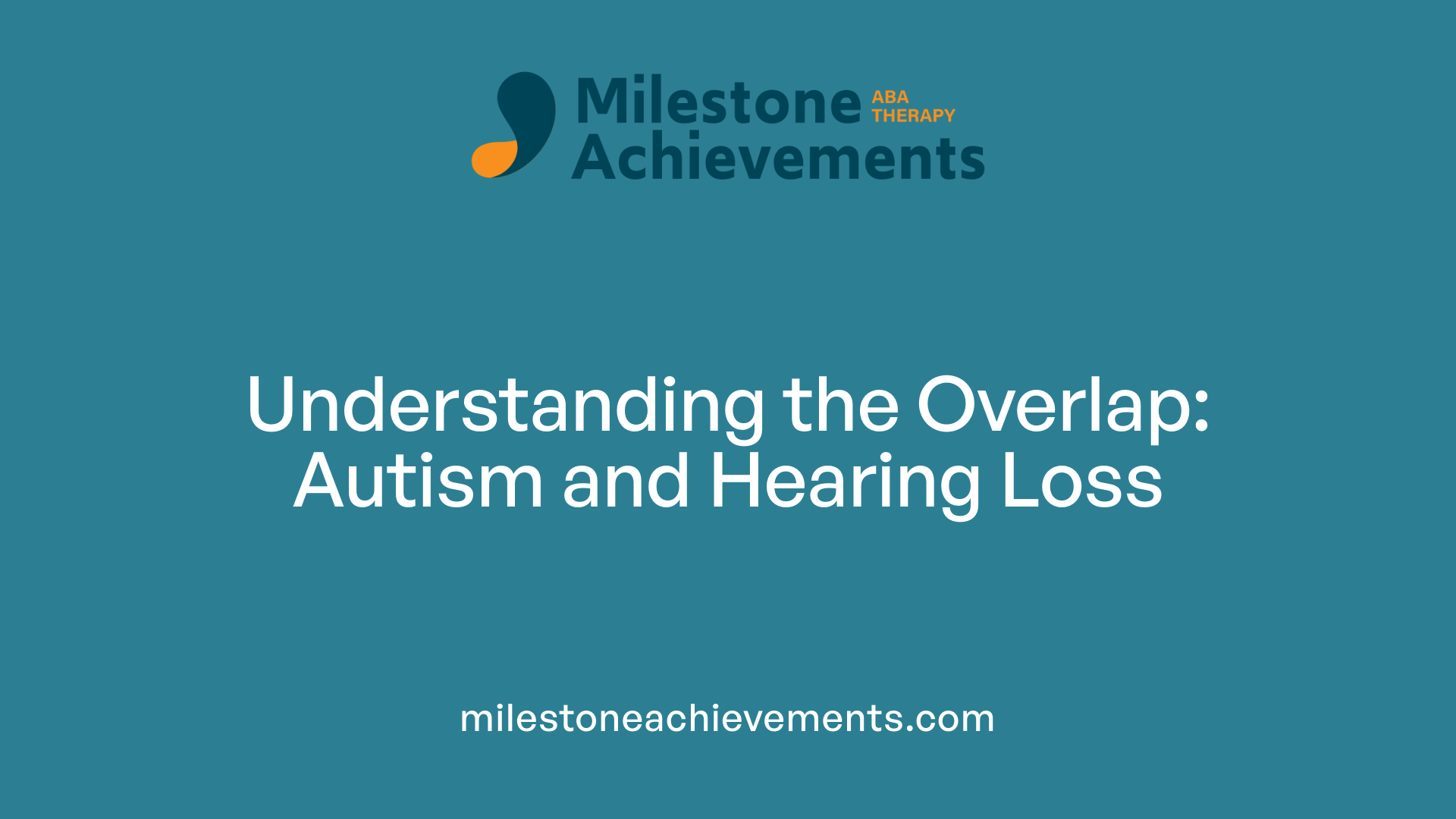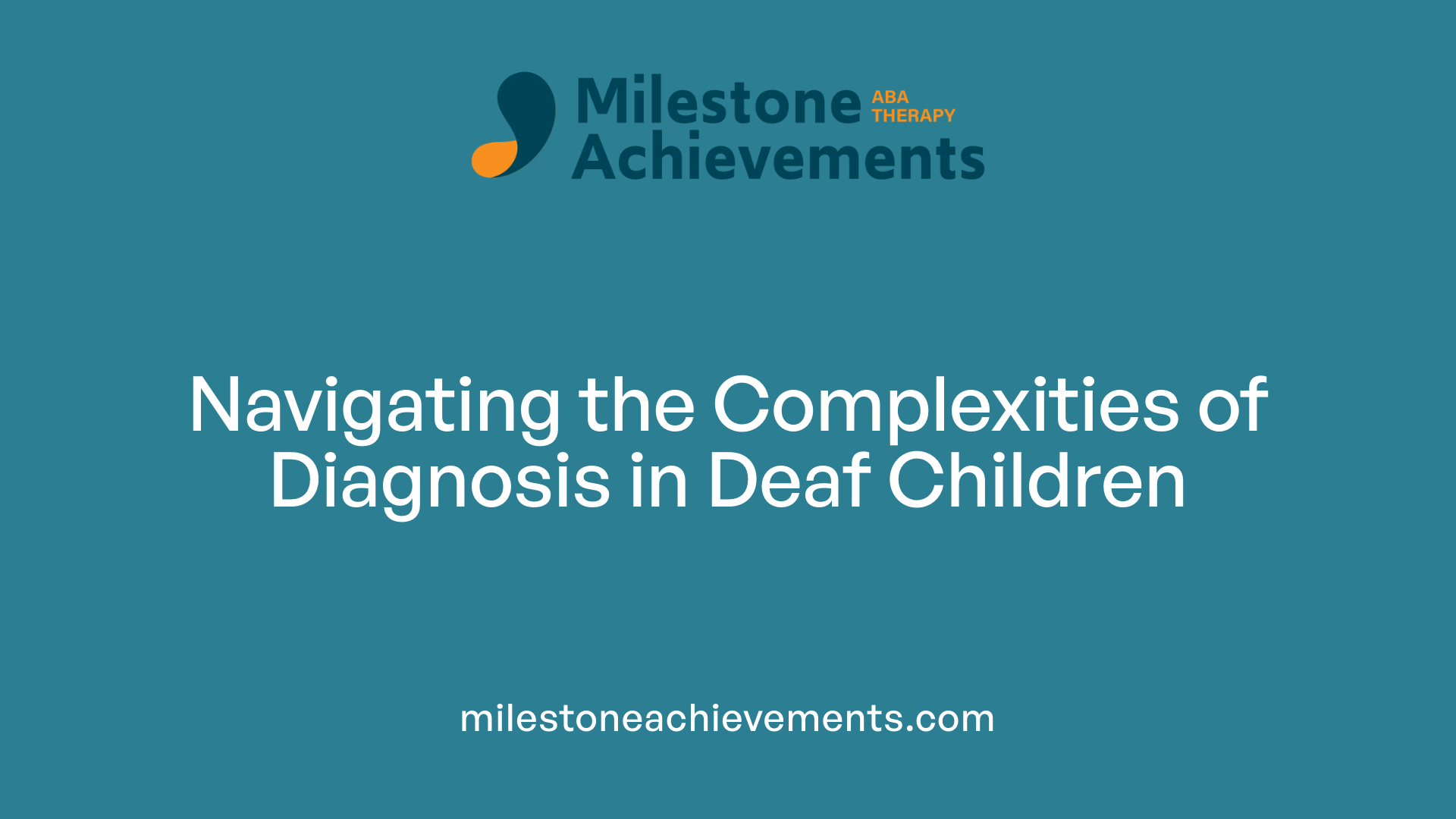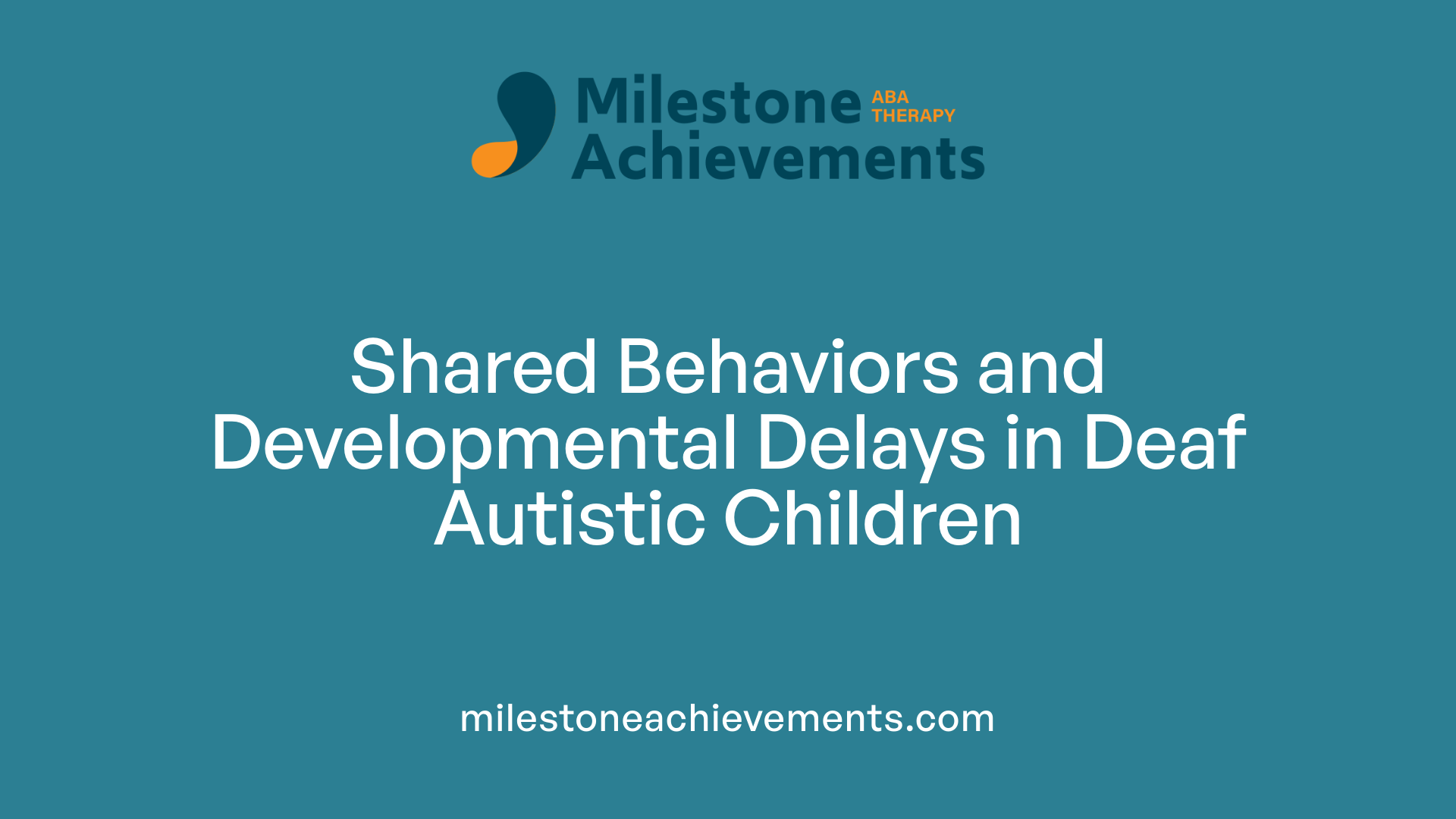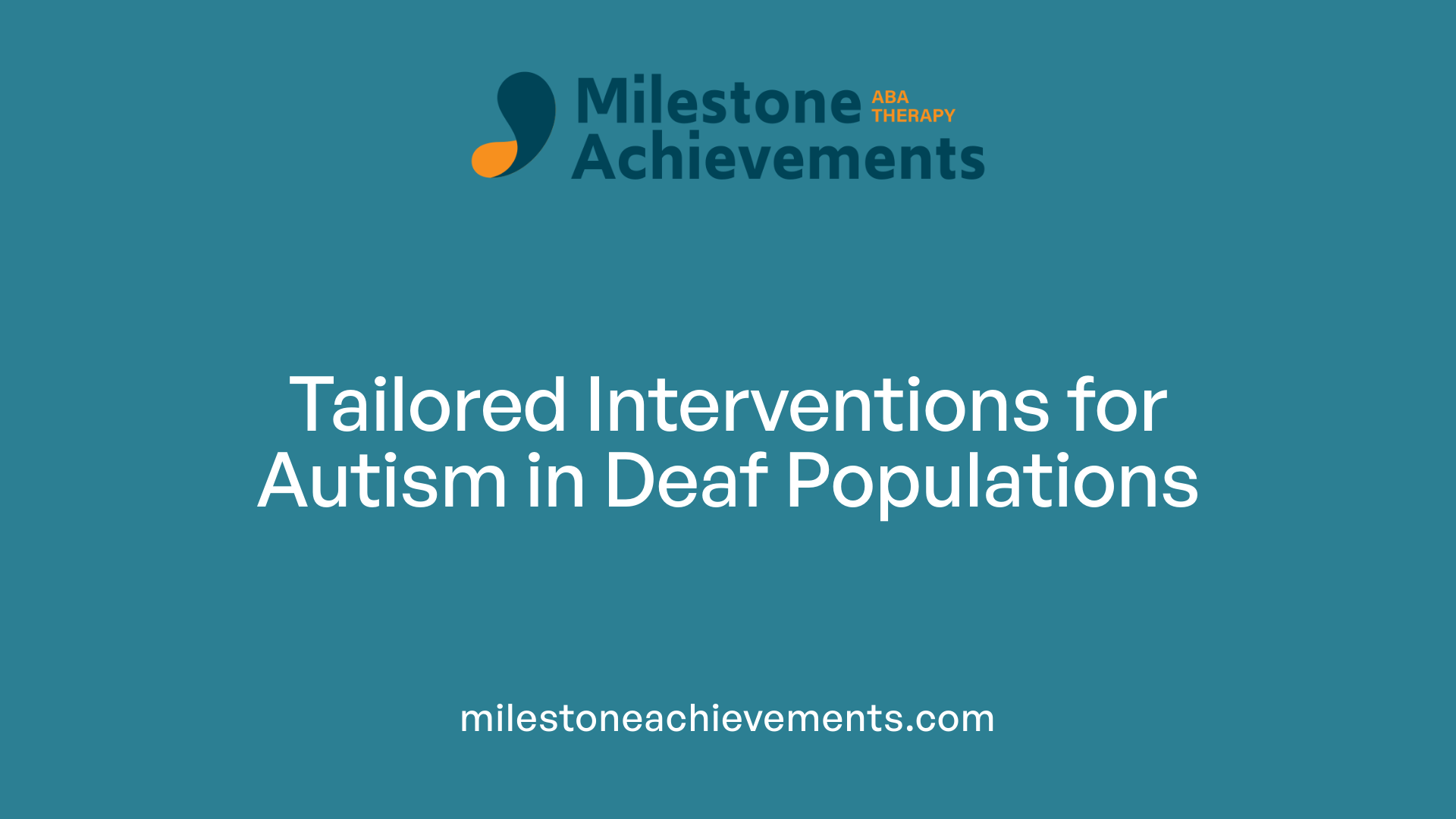Deafness and Autism Co-Occurrence
Examining the Link Between Hearing Loss and Autism Spectrum Disorder

Understanding the Complex Intersection of Deafness and Autism
The co-occurrence of deafness and autism spectrum disorder (ASD) presents unique diagnostic and developmental challenges. While these conditions are distinct, their overlapping symptoms often complicate early detection, intervention, and management. This article explores the prevalence, assessment strategies, behavioral features, and implications for treatment and education for individuals affected by both conditions, providing insights grounded in recent research and clinical practice.
Prevalence and Significance of Co-Occurrence

What is the prevalence rate of autism among children with deafness or hearing loss?
Children who are deaf or hard of hearing (D/HH) are at a significantly higher risk of co-occurring autism spectrum disorder (ASD) compared to the general population. Research indicates that between 4% and 7% of children who are D/HH also have ASD, which is notably higher than the approximate 1.7%–2% prevalence in the general population. Specifically, some studies report rates of autism in children with profound hearing loss around 6% to 7%. This elevated prevalence underscores the importance of diligent screening and early diagnosis in this population.
The Brooklyn-based studies utilizing large datasets, like the Autism and Developmental Disabilities Monitoring (ADDM) network, have also confirmed that the co-occurrence of autism with hearing impairments is more common than expected by chance. For instance, one nationwide research effort found that 6% of children with hearing problems also had autism, highlighting a strong association.
What shared risk factors contribute to both autism and deafness?
The connection between autism and deafness is partly rooted in shared etiologies, such as genetic and environmental risk factors. Several genetic syndromes are associated with both conditions, including:
- Fragile X syndrome
- CHARGE syndrome
- Trisomy 21 (Down syndrome)
- Usher syndrome
- Congenital cytomegalovirus (CMV) infection
Prematurity and low birth weight are also common risk factors that increase susceptibility to both autism and sensory impairments. These shared factors can influence neural development, affecting sensory processing, social communication, and behavioral regulation.
Research also points to a familial genetic component, where mutations or hereditary syndromes increase the likelihood of both conditions occurring in the same individual. Environmental insults during prenatal or early postnatal periods further heighten risks.
How does the prevalence of autism in children with hearing loss compare with the general population?
When comparing children with hearing loss or deafness to the broader population, the prevalence of autism is notably higher.
| Population Group | Estimated Autism Prevalence | Notes |
|---|---|---|
| General population | 1.7%–2% | Based on recent epidemiological surveys |
| Children with hearing loss/deafness | 4%–7% | Studies from multiple regions, including the U.S. |
| Children with sensory impairments (hearing/vision) | Up to 7% | Higher occurrence, especially in those with additional disabilities |
This contrasts with the general population, underscoring the added vulnerability for children with sensory impairments. The delayed diagnosis, varied presentations, and difficulty in assessment contribute to this increased prevalence.
Why is early detection and intervention in deaf or hard-of-hearing children critical?
Early diagnosis of autism in children who are D/HH can significantly impact outcomes. The delayed recognition—children often are diagnosed with ASD around 5.5 to 6.5 years compared to about 3 years in hearing children—can hinder timely access to intervention strategies.
Early interventions tailored for sensory impairments, including visual supports, communication systems like sign language or AAC devices, and behavioral therapies such as applied behavioral analysis, can facilitate better communication, social interaction, and developmental progress. Multidisciplinary teams involving audiologists, speech-language pathologists, and psychologists are vital for comprehensive assessments.
In light of these facts, expanding screening protocols to incorporate sensory considerations and developing validated diagnostic tools specific to D/HH populations are essential steps toward improving diagnostic accuracy and intervention efficacy.
Diagnostic Challenges and Assessment Strategies

What is the most common co-occurring condition with autism?
Autism often occurs alongside other health and developmental conditions. The most frequent comorbid condition is attention deficit hyperactivity disorder (ADHD), which affects approximately 35.3% of autistic children and 21.1% of autistic adults on Medicaid. In addition to ADHD, many individuals with autism face issues such as gastrointestinal disorders, epilepsy, anxiety, sleep problems, and mood disorders like depression and bipolar disorder.
These concurrent health concerns underline the importance of comprehensive healthcare and multidisciplinary management for autistic individuals. Recognizing and addressing these co-occurring conditions can significantly improve quality of life and aid in more accurate diagnoses and tailored interventions.
Is there a correlation between autism and deafness?
While autism and deafness are distinct conditions, they can co-occur. Around 1 in 59 children with hearing loss are also diagnosed with autism. Some research shows that a notable portion — up to 40% — of children with hearing impairments display behaviors associated with autism, such as social communication difficulties and repetitive behaviors.
However, there is no direct causal relationship between the two. The co-occurrence is influenced by shared risk factors like prematurity, genetic syndromes, or neurological vulnerabilities. It's essential to differentiate between hearing-related developmental delays and true autism traits through thorough assessment.
Differences in diagnosis timing between deaf and hearing autistic children
One notable challenge is the age at which autism is diagnosed in deaf versus hearing children. Studies show deaf autistic children are typically diagnosed later, often around 5.5 to 6.5 years old, compared to about 3 years in hearing children. This delay stems from difficulties in applying standard screening tools, which are primarily developed for hearing populations.
Early diagnosis is critical for initiating interventions that support communication and social skills. The late diagnosis in deaf children emphasizes the need for improved screening methods tailored to their unique needs.
Limitations of standard autism screening tools for deaf populations
Most conventional autism assessments, like the ADOS-2 and ADI-R, are designed for hearing populations. These tools rely heavily on spoken language and typical communication behaviors, making them less suitable for deaf children.
In response, clinicians adapt these tools by incorporating sign language, visual supports, and scoring adjustments. While these adaptations show promise, they are still undergoing validation and are not yet standardized for widespread clinical use.
Adaptations in assessment methods, including the use of sign language and virtual tools
To meet the unique needs of deaf individuals, assessment approaches have evolved. Sign language interpreters and visual communication methods are integrated into evaluations. Additionally, virtual assessment tools, like TELE-ASD-PEDS and CARS-2, have been adopted, especially during the COVID-19 pandemic.
These virtual tools are modified to account for hearing and communication differences, providing remote evaluation options that can reach underserved populations. However, their validity is still being studied, and they are yet to become the standard in clinical practice.
Clinician expertise and multidisciplinary approaches in diagnosis
Diagnosing autism in deaf children requires a team of specialists, including audiologists, speech-language pathologists, psychologists, and other professionals trained in both deafness and autism. This collaborative approach ensures a comprehensive understanding of the child's communication modalities, cognitive abilities, and behavioral patterns.
The evaluation process often involves observing behavioral phenotypes, developmental history, and sensory processing. A multidisciplinary team can better distinguish between communication delays caused by hearing loss and true autism traits.
Table: Summary of Assessment Strategies for Autism in Deaf Children
| Strategy | Description | Advantages | Limitations |
|---|---|---|---|
| Standard tools (adapted) | Use of ADOS-2, ADI-R with sign language and scoring adjustments | Established benchmarks | Validation still underway |
| Visual and alternative communication | Sign language, AAC devices, visual supports | Improves accuracy | Requires trained professionals |
| Virtual assessments | TELE-ASD-PEDS, CARS-2 micro-behavioral evaluations | Remote access, safer during pandemics | Validation ongoing |
| Multidisciplinary teams | Collaborative evaluations with various specialists | Holistic understanding | Resource intensive |
Understanding these strategies helps improve early detection and intervention, ultimately supporting better developmental outcomes for deaf and hard-of-hearing children with autism.
Behavioral and Developmental Characteristics

What are the shared behavioral features of children with both autism and deafness?
Children with both autism and deafness often exhibit behaviors that overlap with their hearing peers with autism, such as challenges in social interactions, difficulty developing and using language, and delays in communication skills. Studies have shown that deaf autistic children display behaviors similar to those seen in hearing autistic children, including repetitive behaviors and restricted interests.
Despite differences in sensory backgrounds, behavioral manifestations tend to converge, emphasizing that autism in deaf individuals is not simply a consequence of deafness but a distinct neurodevelopmental condition.
What communication challenges and social interaction difficulties are common?
Communication difficulties are prominent both in children with autism and those who are deaf. Deaf autistic children often struggle with expressive and receptive language, which hampers social interactions and the interpretation of social cues. They may not develop eye contact, struggle with turn-taking, and have difficulty understanding facial expressions or gestures, which are critical for social engagement.
The use of sign language or alternative communication methods, such as augmentative and alternative communication (AAC) devices, can help mitigate some of these challenges, although they require tailored interventions and trained professionals.
How do developmental delays manifest in children with dual diagnosis?
Children diagnosed with both autism and deafness typically experience developmental delays, particularly in speech, language, and social skills. These delays are often more pronounced and diagnosed later than in children with only one of the conditions. For example, the median age of ASD diagnosis is around 5.5 to 6.5 years for deaf children, compared to about 3 years for hearing children.
These delays can affect play, communication, and the development of social relationships, which are crucial during early childhood development. Early detection through comprehensive, multidisciplinary evaluations can help initiate interventions sooner.
How does sensory processing impact their behavior?
Sensory processing issues are common in children with autism and can be compounded in deaf children due to their auditory impairments. Sensory processing difficulties include hypersensitivity or hyposensitivity to stimuli, leading to behaviors such as self-stimulation, withdrawal, or distress when faced with sensory overload.
In deaf autistic children, challenges in processing sound stimuli can affect their responsiveness to environmental cues, further affecting social engagement. Visual supports, structured routines, and sensory integration therapies can be beneficial in managing sensory-related behaviors.
What is the impact of late diagnosis on development?
Delayed diagnosis of autism in deaf children—often by about 3 years later than in hearing peers—can hinder early intervention efforts. Early diagnosis is critical for implementing evidence-based strategies that improve communication, social skills, and behavior.
Late identification may result in missed opportunities for developmental milestones, increased behavioral challenges, and social isolation. Therefore, improving screening tools suitable for deaf populations and raising awareness among professionals is essential to promote earlier detection.
| Aspect | Typical Development | Challenges in Deaf Autism | Implications |
|---|---|---|---|
| Language | Develops early with auditory input | Delayed or atypical language development; may use sign language | Early intervention with visual supports is vital |
| Social skills | Use of eye contact, gestures | Difficulties interpreting social cues; limited social engagement | Social skills training tailored for deaf children helps |
| Behavioral patterns | Adaptive behaviors, exploration | Repetitive behaviors, sensory sensitivities | Behavioral interventions adapted for sensory needs are necessary |
| Diagnosis age | Around 3 years | 5.5–6.5 years on average | Screening improvements needed for earlier detection |
Understanding these overlapping behavioral features and developmental challenges underscores the importance of multidisciplinary approaches. Speech and language therapy, behavioral interventions, and family support are crucial for helping children with dual diagnoses reach their full potential.
Implications for Intervention and Management

What is the most common co-occurring condition with autism?
Autism often does not occur in isolation. One of the most frequent co-occurring conditions is attention deficit hyperactivity disorder (ADHD). Research shows that around 35.3% of children with autism also have ADHD, and about 21.1% of autistic adults with Medicaid are affected by it. Besides ADHD, many individuals with autism face other health challenges such as gastrointestinal disorders (approximately 21%), seizures (epilepsy), anxiety (up to 26%), sleep disturbances, and mood disorders like depression or bipolar disorder. These overlapping conditions are common across different age groups and significantly impact quality of life, emphasizing the need for comprehensive health management and tailored interventions for autistic individuals.
Is there a correlation between autism and deafness?
While autism and deafness are separate conditions, their co-occurrence is notable. Up to 40% of children with hearing loss also show signs of additional disabilities, including autism. The prevalence of autism within the deaf or hearing-impaired population is estimated at about 1 in 59 children, which is higher than in the general population. Despite overlapping features such as sensory processing challenges and communication difficulties, these conditions are distinct developmental issues. Proper diagnosis often requires early screening, detailed assessment, and multidisciplinary collaboration to differentiate between the two and plan appropriate support.
Tailored therapeutic approaches for children with both conditions
Children with concurrent autism and deafness benefit from specialized interventions that address their unique needs. Visual supports, sign language, and augmentative and alternative communication (AAC) devices like picture exchange systems enable effective communication. Applied behavioral analysis (ABA) and functional behavioral assessments help address behavioral challenges, while sign language and visual cues support language development. Therapy plans must be individualized, sensitive to hearing status, and incorporate communication modalities preferred by each child.
Use of visual supports, sign language, and AAC devices
Visual supports are fundamental in supporting children with deaf autism, as they enhance understanding and reduce frustration. Sign language not only facilitates communication but also fosters social interactions and language skills. AAC devices, including picture exchange communication systems, speech-generating devices, and sign language apps, provide options for children who struggle with spoken language. These tools help bridge communication gaps and promote engagement across social and educational settings.
Significance of early diagnosis for better outcomes
Early identification of autism in children with hearing loss is vital. It allows timely access to intervention programs that target communication, social skills, and behavior management, leading to better developmental outcomes. Challenges in diagnosis often cause delays, with many children identified several years after initial concerns. Implementing screening tools specific to the deaf and hard-of-hearing population and routine developmental surveillance can expedite diagnosis, enabling childhood support that adapts to each child's pace.
Family involvement and educational strategies
Parents and caregivers play a crucial role in early intervention. Creating a supportive environment for communication—whether through signing, visual cues, or AAC—is essential. Family-centered approaches empower caregivers to reinforce skills at home and advocate for their children’s needs. Educational strategies such as individualized education plans (IEPs), bilingual-bicultural approaches, and inclusive classroom practices are vital. These strategies promote optimal learning, socialization, and emotional well-being.
Multidisciplinary team roles and evidence-based practices
Effective management involves a team of specialists including audiologists, speech-language pathologists, psychologists, and educational professionals. This team conducts comprehensive assessments, develops personalized intervention plans, and monitors progress. Evidence-based practices like ABA, functional behavioral assessment, and visual supports are adapted for children with auditory and developmental differences. Continuous collaboration ensures that interventions are relevant and effective, leading to improved communication and social outcomes.
| Aspect | Details | Additional Notes |
|---|---|---|
| Co-occurring conditions | ADHD, gastrointestinal disorders, epilepsy, anxiety, sleep disorders | These impact diagnosis and management |
| Communication tools | Sign language, AAC devices, visual supports | Critical for effective engagement |
| Early diagnosis | Critical for better outcome | Implement screening tailored for D/HH children |
| Family & education | Supportive environment, tailored IEPs | Promotes development in social and learning skills |
| Team roles | Audiologists, speech therapists, psychologists | Ensures comprehensive, coordinated care |
Search query
For further guidance, look up “Intervention strategies for deaf autism spectrum disorder” to explore various approaches, tools, and practices aimed at supporting this complex population.
Educational and Support Strategies
What is the most common co-occurring condition with autism?
Several conditions often exist alongside autism, impacting how children learn and develop. The most frequent co-occurring condition is attention deficit hyperactivity disorder (ADHD), affecting roughly 35.3% of children with autism and 21.1% of autistic adults on Medicaid. Besides ADHD, children with autism frequently experience gastrointestinal issues, with about 21% affected, as well as epilepsy, anxiety—which can affect up to 26%—sleep disorders, and mood disturbances such as depression and bipolar disorder.
These co-morbidities can complicate the educational process, making comprehensive, multidisciplinary approaches essential. Strategies that address both behavioral and medical needs are crucial for supporting the child's overall development and promoting social engagement.
Is there a correlation between autism and deafness?
Research indicates that autism and deafness do not have a direct or consistent correlation; however, some children do have both. Interestingly, approximately 40% of children with hearing loss display additional disabilities, including autism.
In children with hearing impairment, the prevalence of autism is estimated at about 1 in 59. This highlights the importance of early detection and tailored interventions. Early diagnosis through multidisciplinary teams can facilitate appropriate educational strategies and support systems, enabling improved communication skills and social integration.
Customized education and support for children with dual diagnoses
For children diagnosed with both autism and hearing loss, traditional educational methods might not be sufficient. Bilingual-bicultural programs that incorporate sign language and culturally relevant teaching are effective in fostering communication.
Visual supports—like picture exchange communication systems (PECS)—are valuable tools that help bridge communication gaps. These approaches are tailored to individual needs, helping children to develop language, social skills, and adaptive behaviors.
Support networks and family empowerment
Families play a critical role in managing dual diagnoses. Support groups and family-centered services provide emotional backing, information, and advocacy. Empowering families with knowledge about the child's condition and available resources improves outcomes.
Organizations such as the American Speech-Language Hearing Association (ASHA) and local community services offer resources, training, and support for families. Engaging in family-to-family support networks can provide shared experiences and practical advice.
Use of bilingual-bicultural and visual communication approaches
Implementing bilingual-bicultural (bi-bi) education that includes sign language and cultural elements facilitates better communication and social inclusion. Visual communication tools like PECS and sign language enable children to express their needs and participate actively in learning environments.
Early intervention with these methods can significantly impact language development and social skills, especially in children with overlapping hearing loss and autism.
Resources and organizations for guidance
Numerous organizations provide guidance and support. Key resources include:
| Organization | Focus Area | Description |
|---|---|---|
| ASHA | Speech and Hearing | Provides guidelines, training, and research updates for professionals and families |
| CDC | Public Health | Offers surveillance data, awareness campaigns, and early screening tools |
| Local Schools | Education | Develops individualized education plans (IEPs) and inclusive programs |
| Autism Speaks | Advocacy and Resources | Provides toolkits, family resources, and community support |
| Parent Support Groups | Family Advocacy | Shares experiences and advocacy strategies |
These organizations help families navigate the complex landscape of dual diagnosis support, ensuring access to appropriate educational and health services.
Long-term developmental support and community engagement
Ongoing support involves continuous assessment of developmental progress, tailored therapeutic interventions, and community participation. Schools are encouraged to implement inclusive education practices, including peer education and awareness programs.
Community engagement promotes social skills and reduces stigma. Peer support programs, social clubs, and extracurricular activities enable children to build friendships and confidence.
Consistent, multidisciplinary support ensures that children with autism and hearing loss can reach their full potential, fostering independent living and meaningful societal participation.
Key Takeaways and Future Directions
The intersection of deafness and autism presents complex diagnostic, behavioral, and educational challenges. Evidence indicates that while these conditions are independent, their co-occurrence—particularly among children with significant hearing impairments—requires specialized assessment tools, early intervention, and a multidisciplinary approach. Increased awareness, tailored support strategies, and ongoing research are essential to improve outcomes. As understanding of their shared and distinct features advances, healthcare providers, educators, and families can better support individuals navigating this dual diagnosis, ultimately fostering more inclusive and effective interventions.
References
- Co-occurrence of autism and deafness: diagnostic considerations
- Assessing Autism in Deaf/Hard-of-Hearing Youths: Interdisciplinary ...
- Co-occurrence of Hearing Loss and Autism Spectrum Disorders
- Treating the Whole Child: When Hearing Loss and ASD Co-Occur
- Deaf Autism: Understanding The Connection Between The Two
- Autism spectrum disorders in 24 children who are deaf or hard of ...
- Co-Occurrence in Autism and Vision or Hearing Loss
- Co-occuring conditions / Minnesota Autism Portal







